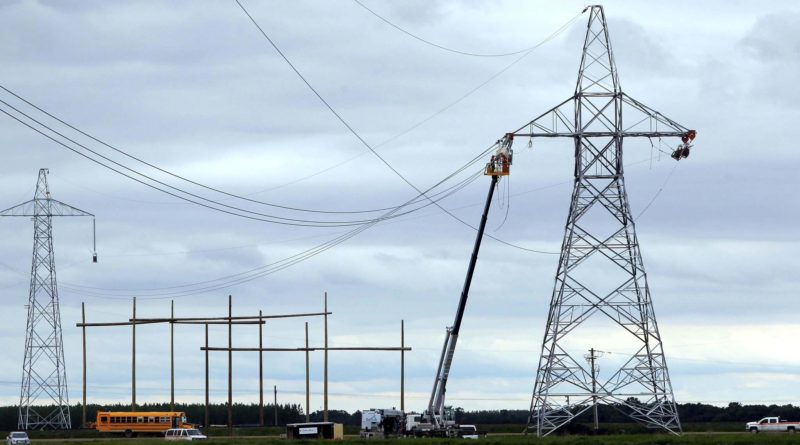Saving Hydro at economy’s expense
Source: Winnipeg Free Press
Photo: Boris Minkevich / Winnipeg Free Press files
Written by: Andrea McLandress is the executive director of the Mining Association of Manitoba Inc.
It is not easy to disentangle the business, finance and politics of Manitoba Hydro. In recent weeks, there has been a flurry of activity, with the Hydro chair and vice-chair doing presentations to business groups and chambers, building the case for their 7.9 per cent general rate increase.
The tone of the message has been clear — using doomsday scenarios and a very limited set of assumptions, Hydro’s senior board members have been telling a business-friendly crowd that the Crown corporation’s debt-equity ratio must be reduced quickly and major rate hikes are the only way to do so.
The result has been a kind of tunnel vision which ignores the fundamental differences between public utilities and Crown corporations, versus the private financial sector, as well as impacts on the rest of the economy.
There may be cause for concern, but not for panic. We need to be clear-eyed about the reality of the situation.
Manitoba Hydro is currently profitable and is forecast to remain that way over the next decade even without the newly proposed 7.9 per cent increases. In the next decade or so, it will face challenging years because of current capital investments due to major capital projects: new dams and the Bipole III transmission line.
The dams could generate returns for decades, and while the route for Bipole III was disputed, its necessity is not: it provides backup to prevent a possible blackout the economic impact of which could be north of $20 billion and could leave hundreds of thousands of Manitobans without power for months.
Manitoba’s current, relatively low and stable power prices are a major competitive advantage, especially for mining companies doing business in Manitoba. Other jurisdictions have lower taxes and depreciation regimes for capital, but Manitoba has lower electricity prices.
Hydro’s management is insisting that they need to be ready for a worst-case scenario, such as a drought, and that they are acting to prevent leaving debt to their children and grandchildren. Manitoba’s credit rating has been downgraded by ratings agencies — in part because of the government’s failure to hit budget targets. To this point, however, downgrades have not been due to Hydro’s debt.
These are all compelling arguments — but they are worth challenging. The scenario being presented by Manitoba Hydro is not the only one, nor is it even the most likely.
The Mining Association of Manitoba agrees with the Manitoba Industrial Power Users Group: Hydro can avoid a debt crunch without having to dramatically increase rates. The existing timeline can get Hydro to a better debt-to-equity ratio without the collateral damage to the rest of the economy.
There appears to have been no consideration or consultation about the impact a 7.9 per cent increase would have on Hydro’s major customers, and how that would affect Hydro’s bottom line.
Hydro’s major customers are businesses that employ tens of thousands of Manitobans; if major companies pull up stakes due to rate hikes, the result will be job losses for communities and lost revenue for Hydro. The rate hikes could further discourage new investment by companies looking to grow in Manitoba. Also, the lost revenue would mean that rates for everyone else would have to go up even more to get Hydro the revenue it now seeks.
By focusing only on hiking prices, Hydro is effectively choosing to build up a cushion of equity by “borrowing” from its customers — private companies and individuals — who have much less financial flexibility, and often have much more debt, than the government does. Hydro’s customers — whether low-income households or companies — do not have the financial flexibility the Manitoba government does to raise revenue through taxes, or to borrow.
The idea that Hydro must engage in massive rate hikes today to reduce a debt pinch “for the future of the province and for our grandchildren” ignores the reality that losing current mine operators would be a disaster.
It should not be an either/or between rate hikes and equity; driving Hydro’s biggest customers out of business will hurt, not help, Manitoba Hydro. There are a number of alternatives that must be considered, including individual contracts for major customers and/or preferential rates for specific rate classes or northern customers.
Ultimately, the responsibility for Manitoba Hydro lies with its board, management and its owners — the Manitoba government — not just its customers. Rate hikes may be inevitable, but destructive ones should not be.
It could be more efficient and effective if the province of Manitoba were to address any issues of shortfalls in income by simply reducing the large payments Hydro is required to make to government each year, in a way that assures a brighter future for Hydro and its customers, too.
